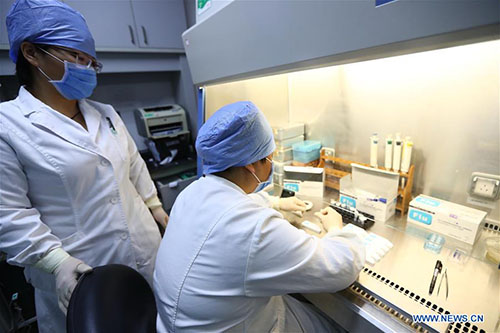Chinese CDC allows simultaneous flu, COVID shots for adults to avoid ‘twindemic’ scenario

Staff members check influenza virus at Capital Pediatrics Research Institute in Beijing, capital of China, Jan. 11, 2018. China's health authority has urged strengthened monitoring and treatment in face of the current influenza outbreak. The National Health and Family Planning Commission (NHFPC) in a circular asked medical organs at all levels to reserve enough antiviral medicines, and allocate medical resources and equipment such as respirators and monitors for timely treatment of severe cases. The commission also demanded close monitoring of the mutation of flu virus strains, and suggested schools have daily check-ups for students. (Xinhua/Zhang Yuwei)
The Chinese Center for Disease Control and Prevention (CDC) released technical guidelines for influenza vaccination for 2022 to 2023 on Thursday, as China's southern regions saw a peak flu season in the summer and the country moves to a avoid a possible "twindemic" scenario of COVID-19 and influenza in the upcoming winter and the spring in 2023.
The new guidelines allow people above the age of 18 to receive both inactivated influenza vaccine and COVID-19 vaccine at the same time, which keeps pace with the current epidemic prevention and control need, some experts said.
The 76-page guidelines said that the COVID-19 pandemic has had an impact on the spread of influenza. Since May, southern provinces in the country saw increasing influenza infection, which reached its peak level in five years during the summer. If COVID-19 is prevalent with influenza at the same time, a large number of cases with similar symptoms of respiratory infection will occur, the document said.
That will increase the complexity of the differential diagnosis of COVID-19 cases, and some COVID-19 cases may be difficult to detect and manage timely, the guidelines said. This will exacerbate the risk of COVD-19 transmission, and cases related to respiratory infections will also lead to increased demand for hospital beds, ventilators and ICU.
For those above the age of 18, they can receive both inactivated influenza vaccine and the COVID-19 vaccine at the same time, and for those below 18, the interval between influenza vaccine and COVID-19 vaccine should remain longer than 14 days, the guidelines showed.
Several groups of people are advised to receive flu vaccines as a priority such as medical workers, security personnel and participants of large-scale activities and vulnerable groups as well as staff in key places such as kindergarten, primary and middle school teachers and students.
The Chinese mainland recorded a total of 380 domestically-transmitted COVID-19 cases and 1,261 asymptomatic infections on Wednesday, and the total domestic infections accumulated to 35,648 since March despite of recent decline in new cases.
The China CDC Weekly issued earlier this month showed that the positive rates of the influenza virus in some southern provinces are still at a high level, especially the influenza A (H3N2) subtype. Among the six detected influenza outbreaks, five of them were connected to H3N2.
"Allowing people above 18 years old to receive both flu and COVID-19 vaccines is keeping up with the times in order to prevent a possible twindemic scenario of COVID-19 and influenza in upcoming winter," Guangzhou-based medical expert Zhuang Shilihe told the Global Times on Thursday. The expert also noted that administering both the flu and COVID-19 vaccines is safe.
At present, the total number of people vaccinated against COVID-19 in the country has reached 1.3 billion, of which 1.27 billion are fully vaccinated, covering and accounting for more than 92 percent and 90 percent of the total population, respectively, Li Bin, vice minister of the National Health Commission, was quoted as saying in media reports on Monday.
Recently, China has continued to ease its visa restrictions for foreigners, with dozens of Chinese embassies having resumed another two types of visa services for foreigners, after it largely suspended issuing visas to foreign students and others more than two years ago at the beginning of the COVID-19 pandemic.
Welcoming back international students does not mean China has relaxed its strict COVID-19 prevention and control measures nor does it mean China has abandoned its dynamic-zero COVID policy, and more foreigners coming to China will surely exert more pressure on the country's epidemic prevention work, which also highlighted the importance of people receiving both the flu and COVID-19 vaccines, experts said.
"Currently, we could see there's much more pressure on the epidemic control work, and more foreigners coming will surely pose new challenges in upcoming months," a Beijing-based immunologist who preferred not to be named told the Global Times on Thursday.


